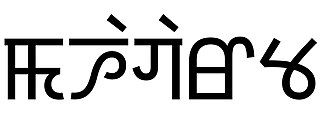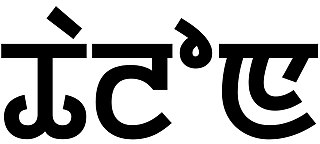Related Research Articles
Indian epic poetry is the epic poetry written in the Indian subcontinent, traditionally called Kavya. The Ramayana and the Mahabharata, which were originally composed in Sanskrit and later translated into many other Indian languages, and the Five Great Epics of Tamil literature and Sangam literature are some of the oldest surviving epic poems ever written.

Charairongba also known as "Eningthou Ningthem Charairongba" was the Meitei king and the ruler of Kangleipak from 1697 to 1709.

Panthoibi, also known as Nongpok Leima, is a goddess associated with civilization, courage, fertility, handicraft, love, victory, warfare and wisdom in the mythology and religion of Ancient Kangleipak. She is a consort of the God Nongpok Ningthou. She is considered to be one of the divine incarnations of Leimarel Sidabi and is also identified as a form of Goddess Nongthang Leima. She is worshipped mainly by the Meitei people in Manipur, Assam, Tripura, Bangladesh and Myanmar.

Numit Kappa is an ancient Meitei language mythological epic literary work. The work is believed to be written around or before 33 AD. It is written in the form of partial poetry and partial prose.

The Henjunaha Lairoulembi, also known as the Henjunaha Lairuklembi, shortly known as the Henjunaha, is a legendary epic love story of Henjunaha Yangleingamba and Thongnang Lairoulembi. It is one of the epic cycles of incarnations of Meitei mythology and folklore, that is originated from Moirang province of Ancient Kangleipak.

Nongpok Ningthou, also known as Sovereign of the East or King of the East, is a deity in Meitei mythology and religion of Ancient Kangleipak. He is the ruling guardian deity of the eastern direction. Legend says Nongpok Ningthou and Panthoibi got united in the Nongmaiching mountains. Later, they were worshipped as the civilization giving deities in Meitei religion.

Konthoujam Tampha Lairembi or Chingphuron Konthousu is a goddess in Meitei mythology and religion (Sanamahism) of ancient Kangleipak. She was formerly a mortal being belonging to the Haorok Konthou clan. She is a consort of the sky god Salailen. Her only child is Khoriphaba.

Meitei mythology or Manipuri mythology is a collection of myths, belonging to the religious and cultural traditions of the Meitei people, the predominant ethnic group of Manipur. It is associated with traditional Meitei religion (Sanamahism). Meitei myths are a part of Meitei culture and explain various natural phenomena, how the human civilization developed, and the reasons of many things happening. Most of the Meitei legends are found in the Meitei language texts.

The ancient legend of Khuyol Haoba and Yaithing Konu is one of the epic cycles of incarnations of Meitei mythology and folklore, that is originated from Moirang kingdom of Ancient Kangleipak. It concerns the fateful love of Khuyol Haoba, an orphan man, for the beautiful Yaithing Konu. Khuyol Haoba was the son of late Khundouremba, a court official of Moirang. Yaithing Konu was the daughter of Luwang Huiningsumba, an influential nobleman of Moirang.

The ancient legend of Wanglen Pungdingheiba and Sappa Chanu Silheibi is one of the epic cycles of incarnations of Meitei mythology and folklore, that is originated from Moirang kingdom of Ancient Kangleipak. It concerns the tragedic romantic adventures of Wanglen Pungdingheiba for his ladylove Sappa Chanu Silheibi . Wanglen Pungdingheiba was a skilled craftsman known for making musical instrument pung. Lady Sappa Chanu Silheibi was a skilful weaving artisan. Both the lovers are equally noted for their talents and good looks, thereby becoming the matters of envy of many young men and women in the kingdom of Moirang.

The Mahabharata is one of the epics of Sanskrit literature that is translated as well as literarily adapted into Meitei language, thereby creating a space for Hindu literature within the granary of Meitei literature.
The Nongmaiching Ching, also known as the Selloi Langmai Ching, is a mountain in Imphal Valley, Manipur. It has an altitude of around 5,133 feet (1,565 m). It is a holy pilgrimage site for the Meitei people. In Meitei mythology and religion (Sanamahism), it is a sacred mountain and the abode of God Nongpok Ningthou and Goddess Panthoibi. In Meitei folklore, the Nongmaiching is described as the hill that produces "the seven days of a week".

The Khongjomnubi Nonggarol is an ancient Meitei language literary narrative text (puya) containing two major stories, first about a group of six Luwang girls turning into the pleiades in the sky, one of them giving birth to a harinongnang and the second about a lady named Haosi Namoinu turning a harinongnang, unable to suffer the extreme cruelty of her stepmother, during her father's absence.

Haosi Namoinu is a character in Meitei mythology and folklore of Ancient Kangleipak. She is the only daughter of lady Pokmabi Laoshigam Chanu and lord Senbi Loikenba. She is the apple of their eyes. Her father was a minister of the then Ancient Moirang kingdom, in charge of collecting tributes from the land of Kabo.

The Panthoibi Khonggul, often misspelled as Panthoibi Khongul, is an ancient Meitei language text, narrating about the quest of deified Meitei princess Panthoibi. The text highlights the love story of Panthoibi and her ultimate lover Nongpok Ningthou, after leaving her former husband's house. It is traditionally attributed to be written by Akoijam Tombi, during the reign of Meitei King Khongtekcha Yoiremba in c. 763 AD.

The Nungpan Ponpi Luwaopa, also known as the Nungban Pombi Luwaoba, is an ancient Meitei language narrative epic text (puya), about the legendary story of a prince of the same title, belonging to the Luwang dynasty, who got back successfully the life of his wife Koubaron Namoinu (Lainaotabi), from the hands of her former consort Thongalen, the God of death and the ruler of the underworld. It is an old story of near tragic end. In the legend, there are fights between a mortal and the gods. It mentions about the dowry system of the then ancient times. It is, in a sense, the reverse of the Chothe Thangwai Pakhangba.

Thāron or the Thārol is an ancient Meitei language text (puya), about the lore of the twelve lunar months of a year. It is the foundation for the Meitei calendar. It describes the changing pattern of nature in the following months. It is one of the masterpieces of the writers of the ancient times.

Many Chings play significant role in different elements of Meitei culture, including but not limited to Meitei folklore, Meitei folktales, Meitei literature, Meitei mythology and Meitei religion (Sanamahism) of Kangleipak.
The Tutenglon is an ancient Meitei language text, based on the saga of the two Meitei princes, Yoimongba and Taothingmang, who took upon themselves the superhuman task of dredging the channels of the biggest and the longest rivers in Kangleipak, the Iril River and the Imphal River. It also describes about the flood that happened during the reign of king Ngangoi Yoimongba in Ancient Kangleipak. The text also mentions that Yoimongba and Taothingmang are the two sons and Lairoklembi is a daughter of Meitei king Khuyoi Tompok. Princess Lairoklembi was married to the chief of Koubru.

Ancient Meitei literature, also termed as Old Manipuri literature, is literature written in the Ancient Meitei language from the earliest texts until the time of King Pamheiba of Kangleipak. All the ancient Meitei literary works are written in the traditional Meitei script. The ancient Meitei language texts, written in Meitei script, are conventionally termed as "the Puyas".
References
- ↑ Arun, Irengbam (2012). Chainarol, Way of the Warrior. Human Rights Alert.
- 1 2 Ayyappappanikkar; Paniker, K. Ayyappa (1997). Medieval Indian Literature: Surveys and selections (Assamese-Dogri). Sahitya Akademi. ISBN 978-81-260-0365-5.
- ↑ "Chainarol Way of Warrior Manipuri Humanitarian Traditions Part 1". www.e-pao.net. Retrieved 25 February 2023.
- ↑ McConnell, Grant D. (1978). Les Langues Écrites Du Monde: Relevé Du Degré Et Des Modes D'utilisation. Les Presses de l'Université Laval. ISBN 978-2-7637-7196-0.
- ↑ Jadavpur journal of comparative literature. Department of Comparative Literature, Jadavpur University. 2006.
- ↑ Singh, Moirangthem Kirti (1998). Recent Researches in Oriental Indological Studies: Including Meiteilogy. Parimal Publications.
- ↑ Singh, Ch Manihar (1996). A History of Manipuri Literature (in English and Manipuri). Sahitya Akademi. p. 36. ISBN 978-81-260-0086-9.
- ↑ Singh, Ch Manihar (1996). A History of Manipuri Literature (in English and Manipuri). Sahitya Akademi. p. 36, 37. ISBN 978-81-260-0086-9.
- ↑ Singh, Ch Manihar (1996). A History of Manipuri Literature (in English and Manipuri). Sahitya Akademi. p. 36. ISBN 978-81-260-0086-9.